There are many elements to a good crisis response, and just as each crisis is different so is the appropriate response. But there are some key elements that unite a good response.
Another aspect that is common to good responses is timely, accessible, and targeted communication. This doesn’t always mean diving headfirst into a response. Take your time to gather the information you need while issuing a holding response, make sure your updates are accessible to all, and ensure you are publishing them where your audience is most likely to access them.
Good crisis responses don’t stop after 24 hours, 48 hours or even a few days or weeks. Cadence is important, be clear about when people can expect your next update and keep communicating throughout the crisis and as the situation returns to normal.
Below we’ve compiled the Best Crisis Responses of 2023, organizing them into a comprehensive list of the Top 10 strategies. While these strategies aren't ranked in any particular order, each one contributes valuable insights to handling crises effectively. We invite you to read through these strategies, share your thoughts, and let us know whether there are others we should add.
One standout strategy employed by organizations in 2023 involved leveraging their websites and utilizing paid advertising to expand and boost the reach of critical information. In addition to ensuring that necessary information reached a wider audience, this strategy also helped demonstrate a commitment to transparency and accountability.
Example: EzriCare, LLC
Crisis: Ezricare Artificial Tears Recall
What we liked about it: Using SEO boosting to put a dedicated information and timeline page at top of Google search results, this page became the first result when searching for “ezricare artificial tears” or “ezricare recall” (third result is EzriCare main website). Information was also quickly added to the top of EzriCare website.


The question of if and how to respond in a crisis is often the preeminent question teams are faced with. While there can be various ways to respond, in the case of an earnest mistake or oversight, the saying “honesty is the best policy,” can be the best course of action. Acknowledging a mistake humanizes an issue, after all it’s something that everyone can relate to, which helps to build your audience’s trust and foster credibility. An honest and transparent response, if timed correctly, can also diffuse a situation quickly and prevent it from growing unnecessarily.
Example: Metropolitan Transportation Authority (MTA)
Crisis: Misspelling spotted in engraved sign in new $11 billion New York terminal
What we like about it: The MTA used honesty and humor to acknowledge the $11 billion spelling error in an engraved quote from acclaimed artist Georgia O’Keeffe was identified after the unveiling of the Long Island Railroad terminal in Grand Central Madison. This clever word play, which highlights the missing “f” in the sign, shows transparency, but also acknowledges the genuine human error.


Harnessing the power of employee advocates remained as valuable as ever. Companies and organizations trained and empowered their workforce to act as ambassadors, utilizing their individual social media profiles to become trusted voices and share content to a broader audience.
Example: Network Rail
Crisis: Landslip outside of London causing train delays
What we like about it: As a trusted voice for Network Rail, this operations director was able to provide additional context into the work being done to address the delays, as well as the partnerships being leveraged to continue operations in the midst of the crisis. This use of an individual employee’s platform helped amplify the organization’s message to a wider audience than they would have otherwise had access to.

Collaboration is key in any crisis response. It’s important to develop strong relationships with partners on blue-sky days and to have open lines of communication both in a crisis and in peacetime. One key way to leverage third-party partners is by utilizing their networks to share critical information to a broader audience.
Example: Maryland Department of Emergency Management
Crisis: I-95 bridge collapse in Pennsylvania
What we like about it: When a section of Interstate-95 collapsed in Pennsylvania, neighboring states jumped in to spread critical information while adding important details that their residents needed to know. This shows the importance of leveraging third-party partners’ networks in a crisis to expand the reach of your messaging. It also shows how third-party partners can adapt messaging for their audiences to boost engagement and interest.
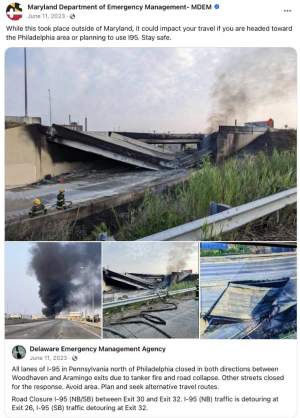
Responding to a crisis through a posted statement is good, but it’s also important to ensure your statement is strategic and uses the right tone. The CAP Method is a proven way to effectively convey empathy, outline actions taken, and provide a broader view on the situation.
Example: B&Q
Crisis: White supremacy book featured in advertisement photo
What we like about it: By using the CAP method, B&Q created a strong response, that was concise, but that didn’t try to spin or avoid the issue at hand. We also like the fact that B&Q added proof points to their CAP statement to support their messaging which showed that they were taking their concerns seriously.
Concern: "We deeply apologise for the offence this may have caused from a product that was offered for sale by a third-party seller. B&Q is committed to creating an inclusive place for our colleagues to work and our customers to shop, and in this instance, this product was not picked up by our screening process.”
Action: “We can confirm we suspended the seller and removed the product, and all images associated with it, from http://diy.com as soon as we became aware of the content.”
Perspective: "We are actively reviewing our screening process to prevent this happening again, as we are committed to maintaining a respectful and inclusive online environment."
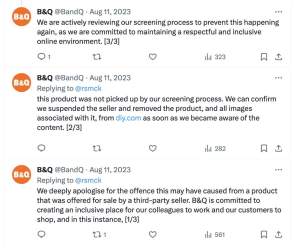
Too often in a crisis, the focus is on external stakeholders. It’s easy to lose sight of another key stakeholder group–those internal to the organization, especially downstream employees who hold a good amount of power and influence over a company’s reputation, public perception, and sustainability long term. In a crisis, it’s important to consider internal communications strategically and thoughtfully.
Example: United Airlines
Crisis: CEO using private airline amid major cancellations and flight delays
What we liked about it: Although many teams intend for internal communications with stakeholders and employees to remain internal, it’s very easy for these communications to be leaked either to media outlets or published on social media. United Airlines CEO Scott Kirby got ahead of this by posting his message to internal stakeholders publicly on LinkedIn following his separate public statement that was released to the media.
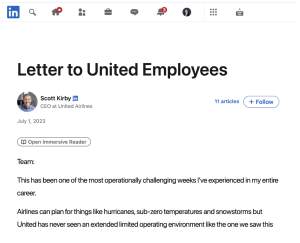
It was no surprise that in 2023 we continued to see the increased spread of misinformation and disinformation, especially during crisis events such as natural disasters. While affected organizations can respond and counter misinformation, it helps a great deal when others, especially with those with large platforms, help stop the spread of misinformation. By providing accurate and timely information, news outlets and influencers can play a crucial role in shaping public perception.
Example: Jason Mamoa
Crisis: Hawaii Wildfires
What we liked about it: With over 17 million followers, actor and Hawaiian native, Jason Mamoa, used his platform following the wildfires on the island of Maui to amplify information about the wildfires, including highlighting that misinformation was being spread along with providing the facts to counter the spread. This is critical as too often in crisis situations, especially natural disasters, misinformation and disinformation can spread quickly adding to the chaos and confusion already associated with such events.
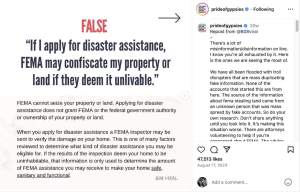
In 2023, photo and video content continued to prove that they were king when it came to the type of content that both the algorithm and audiences favored most. Videos in particular have a unique ability to convey emotions and messages effectively during a crisis. Organizations that incorporated videos in their crisis communication response not only engaged their audience on a more personal level, but also delivered information in a visually compelling manner.
Example: EFR Skips
Crisis: Employee driver involved in accident with motorcyclist
What we like about it: While it’s a simple video, EFR Skips used a TikTok video to respond to a viral TikTok video involving one of their drivers. According to the comments, people appreciated the company for standing up for their driver. Posting a rebuttal statement on Tiktok was also strategic as it was the platform where the original viral video originated, making it more likely that the right audience would see their response.
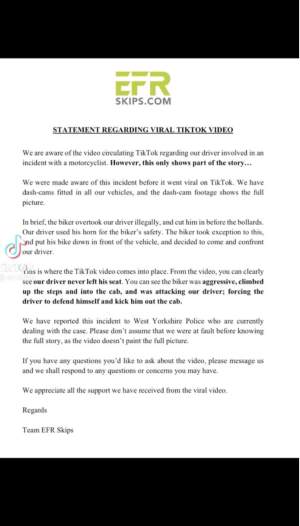
In order to present a more visual approach, many organizations choose to communicate statements on social media using graphics. While this can be a good way to get information out during a crisis, keep disability accommodations in mind so that everyone can access the information.
Example: Royal Society for the Protection of Birds (RSPB) England
Crisis: Angry twitter post against UK Prime Minister’s administration
What we like about it: While the RSPB didn’t use alt-text for their statement image, they made sure to include the text of the statement in the post as well as on the image. This not only improves accessibility, but also allows the social media channel’s auto-translator to translate the statement for an even broader audience.
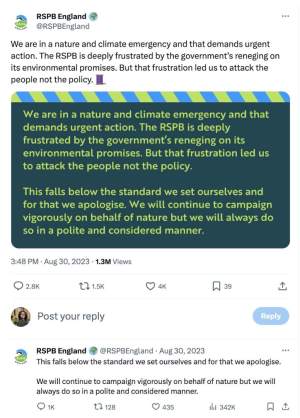
Social media is social–it’s not simply just a broadcast tool, but a two-way street. In order to foster engagement and boost the reach of posts, organizations must also prioritize active engagement with their audiences, both during crisis and in peacetime. This can include responding to comments and addressing questions and concerns. Active engagement helps foster a sense of community and reassures stakeholders that their voices are being heard.
Example: McDonald’s
Crisis: Investigation by BBC News
What we like about it: McDonald’s UK actively monitored social media and responded to various reply tweets that followed their statement. This helps demonstrate authenticity and shows audiences that the corporation is paying attention to what members of the public have to say.
The best crisis responses of 2023 showcased a diverse range of strategies that companies and organizations employed to navigate challenging situations successfully. By learning from these experiences, you can help build your crisis resilience and enhance your own crisis response capabilities.
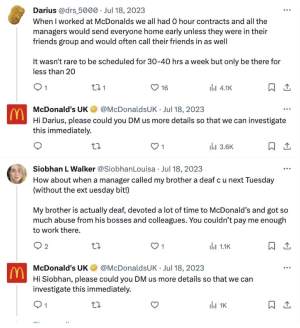
Download a copy of our free resource: 10 tips for crisis response